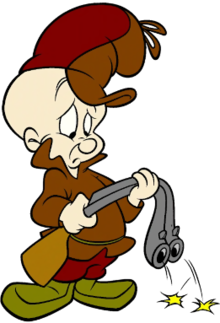| Elmer J. Fudd | |
|---|---|
| Looney Tunes/Merrie Melodies character | |
 | |
| First appearance | Little Red Walking Hood (November 6, 1937) (prototype version)[1][2] Elmer's Candid Camera (March 2, 1940) (official/finalized version) |
| Created by | Tex Avery Chuck Jones |
| Voiced by | Mel Blanc (1937–1939-1940, 1942, 1946, 1950, 1954, 1956–1957, 1959–1989) Danny Webb (1938–1939) Roy Rogers (1938, singing voice in A Feud There Was) Arthur Q. Bryan (1940–1959) Frank Graham (1944) Dave Barry (1958) Hal Smith (1960–1965) Paul Kuhn (1989) Jeff Bergman (1990–1992, 1997, 2002–2004, 2013–present) Greg Burson (1990–2001) Joe Alaskey (1992, 2000) Frank Welker (1993, 1995) Billy West (1996–2015) Tom Kenny (2004–2005) Brian Drummond (Baby Looney Tunes; 2002) Eric Bauza (2018, 2021–present) (see below) |
| In-universe information | |
| Alias | Elmer, Elmer Fudd (full name), Elmer J.[3] Fudd |
| Species | Human |
| Gender | Male |
| Occupation | Hunter |
Elmer J.[4] Fudd is an animated cartoon character in the Warner Bros. Looney Tunes/Merrie Melodies series and the archenemy of Bugs Bunny. His aim is to hunt Bugs, but he usually ends up seriously injuring himself and other antagonizing characters. He speaks in an unusual way, replacing his Rs and Ls with Ws, so he often refers to Bugs Bunny as a "scwewy" or "wascawwy (rascally) wabbit". Elmer's signature catchphrase is, "Shhh. Be vewy vewy quiet, I'm hunting wabbits", as well as his trademark laughter.
The best known Elmer Fudd cartoons include Chuck Jones' work What's Opera, Doc? (one of the few times Fudd bested Bugs, though he felt bad about it), the Rossini parody Rabbit of Seville, and the "Hunting Trilogy" of "Rabbit Season/Duck Season" shorts (Rabbit Fire, Rabbit Seasoning, and Duck! Rabbit, Duck!) with Fudd, Bugs Bunny, and Daffy Duck. An earlier prototype of character named Elmer set some of the recognizable Elmer's aspects before the character's more conspicuous features were set.